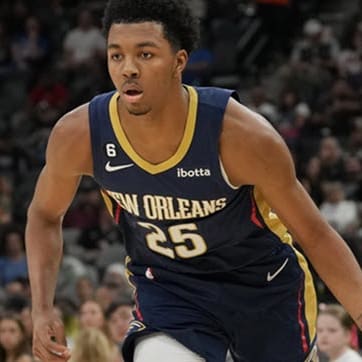This article is part of our Nerd Alert series.
It's no secret that advanced stats are of great aid to fantasy baseball owners or that such metrics give a competitive advantage to those who use them. Nor must one look far and wide for telling examples.
Take the case of Cincinnati Red Jay Bruce, for instance. In 2009, he slashed .223/.303/.470 in 387 plate appearances. To owners who looked no further than those disappointing numbers, Bruce appeared to be a player to avoid in 2010. But for those who considered Bruce's component stats, the root of Bruce's deflated batting line was obvious: a .221 batting average on balls in play (BABIP). Hitters exercise only moderate control over their BABIPs, so it followed that, rather than being bad per se, it was most likely the case that Bruce was just unlucky.
In fact, Jay Bruce's 2010 was a great success, as the outfielder proceeded to bat .281/.353/.493 with a much higher (and perhaps unsustainably high) .334 BABIP. Those owners who evaluated Bruce correctly -- who used all the available information -- were rewarded. Of course, not all such cases work out so nicely, but the point remains: meaningful information is of great assistance to fantasy success.
Unfortunately, for our purposes, there's a problem with the Jay Bruce example -- namely, that Bruce is a baseball player. The regression of his BABIP back up to the mean, his success in 2010 after the underwhelming 2009: it's of little concern to fantasy basketball owners.
So we come to these two questions:
It's no secret that advanced stats are of great aid to fantasy baseball owners or that such metrics give a competitive advantage to those who use them. Nor must one look far and wide for telling examples.
Take the case of Cincinnati Red Jay Bruce, for instance. In 2009, he slashed .223/.303/.470 in 387 plate appearances. To owners who looked no further than those disappointing numbers, Bruce appeared to be a player to avoid in 2010. But for those who considered Bruce's component stats, the root of Bruce's deflated batting line was obvious: a .221 batting average on balls in play (BABIP). Hitters exercise only moderate control over their BABIPs, so it followed that, rather than being bad per se, it was most likely the case that Bruce was just unlucky.
In fact, Jay Bruce's 2010 was a great success, as the outfielder proceeded to bat .281/.353/.493 with a much higher (and perhaps unsustainably high) .334 BABIP. Those owners who evaluated Bruce correctly -- who used all the available information -- were rewarded. Of course, not all such cases work out so nicely, but the point remains: meaningful information is of great assistance to fantasy success.
Unfortunately, for our purposes, there's a problem with the Jay Bruce example -- namely, that Bruce is a baseball player. The regression of his BABIP back up to the mean, his success in 2010 after the underwhelming 2009: it's of little concern to fantasy basketball owners.
So we come to these two questions: what's the state of advanced metrics in basketball and -- more importantly, for our concerns -- how can it help fantasy owners?
The first answer to those questions is as follows: because basketball is fluid and not, like baseball, turn-based, it's harder to understand the contributions of an individual player. Does an assist, for example, belong to the player passing or scoring the ball? Were Steve Nash to play on Minnesota, for example, would he average as many assists per game? Would the players around him all of a sudden become better? Would he be merely average?
Readers might have strong reactions to these questions -- and such reactions might be totally valid -- but the truth is that, we don't know what would happen, either to Nash or the Timberwolves.
John Hollinger at ESPN -- and Dean Oliver before him -- have done a great deal to produce meaningful stats for NBA players. Stats like Player Efficiency Rating (PER) and the various iterations of plus/minus help us to understand (some part of) a player's value to his team. Those are fine, but not particularly helpful for fantasy purposes.
As for what is particularly helpful -- well, the goal of this weekly column will be to find that out. Because advanced basketball stats are still a bit of an untamed frontier, it'll be my business to discern what is and what isn't meaningful to fantasy owners.
To begin, I've included three websites below that will likely provide the bulk of that data I'll be parsing here. Note, please, that I'm not suggesting these are the only worthy basketball-related sites on the entire Internet. They're merely the ones with which I feel most comfortable. (And, of course, any suggestions are welcome in the comments section.)
Site: Hoop Data
URL:http://hoopdata.com/default.aspx
Useful Thing(s): Attempts and FG% by shot location. Rebounding rates. A lot of other stuff, too.
Comments
If there's an advanced stat that can be instantly useful for fantasy owners, it's field-goal percentage by shot location -- and it's available at Hoop Data. Here, player shot attempts and field-goal percentages are divided into five distances: At Rim, <10 Feet, 10-15 Feet, 16-23 Feet, and Threes. Though some cursory Googling reveals little in the way of serious regression analysis on shot-location numbers, there's a lot that can be learned just from observation and common sense.
Like, consider the case of Luke Ridnour. Last year, after six seasons of posting field-goal percentages in the 40%-43% range, he finished with a 47.8% mark from the field. Looking at his player page, one sees that, while generally shooting somewhere around 43% from 16-23 feet, Ridnour led all guards in 2009-2010 (by a lot!) with a 57.0% mark from that range. That's good for anyone who owned him last year, but there's a great chance that Ridnour will regress to career levels this season.
On the other hand, one finds that Dwyane Wade is currently only shooting 16.0% from 16-23 feet after years of averaging around league-average (39% or 40%) from that range. Additionally, one sees that Wade is averaging more than twice as many shots per game from within 10 feet than in years past (3.4 this year, compared to an average of 1.5 previously). This will likely also help his percentages.
Site: Popcorn Machine
URL:http://www.popcornmachine.net/
Useful Thing(s): Flow charts, all day and all night.
Comments
Fantasy value is tied closely to playing time. Regardless of talent, a player who sees only 15 minutes per game will offer no fantasy value. Conversely, 35 minutes per game can make even Ryan Gomes or Al Thornton valuable.
The problem is, sometimes playing time is hard to read. Was a player being entrusted with important minutes, or was he merely taking advantage of garbage time? It's not always easy to tell from the box score.
Consider a recent appearance by San Antonio's Tiago Splitter. After suffering consecutive DNPs, Splitter played a full 26 minutes Saturday, November 20, versus Cleveland. It was a pretty excellent performance, too: 18 points, five rebounds, two blocks, two steals. One can see that San Antonio won by quite a bit (116-92), but it's impossible from the box score to discern when exactly Splitter played.
Luckily, Popcorn Machine's game-flow charts do just that. Looking at the flow chart for the game in question, we see that Splitter played the last 15 minutes of the game -- during which time the Spurs were generally up by over 10 points. This is helpful: from the game-flow chart, we learn that, while Splitter played quite well, it was mostly in a mop-up capacity. We can conclude with some certainty that coach Gregg Popovich has not all of a sudden handed him big minutes at the five.
Site: Basketball Reference
URL:http://www.basketball-reference.com/
Useful Thing(s): Projections. Win shares. Plus/minus stuff. Statgeekery, in general.
Comments
Basketball Reference is cool less for the numbers on its stats pages -- although, there's relevant stuff there, too -- but for the discussions and research that show up on the site's well-run blog.
Before the season, for example, the team released statistical projections for close to 450 NBA players using their Simple Projection System (based on the Marcel system devised by baseball's Tom Tango). Though the projections are intended to represent "the most basic forecasting system you can have, that uses as little intelligence as possible," the numbers are still helpful for organizing one's perceptions of different players. Furthermore, the numbers are all normalized on a per-36-minute basis, making it easier to compare players to each other.
DatabaseBasketball.com is another source for basic historical stats.
Besides that, it's more just the general commitment of the site's authors to discovery and question-asking that I find useful.









